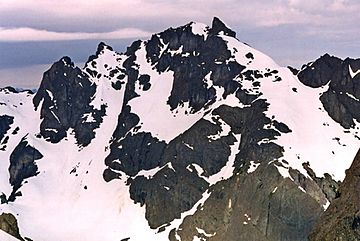Inner Constance facts for kids
Quick facts for kids Inner Constance |
|
|---|---|

Inner Constance seen from Mount Constance
|
|
| Highest point | |
| Elevation | 7,680 ft (2,340 m) |
| Prominence | 1,147 ft (350 m) |
| Geography | |
| Location | Jefferson County, Washington, United States |
| Parent range | Olympic Mountains |
| Topo map | USGS Mount Deception |
| Geology | |
| Age of rock | Eocene |
| Type of rock | Tilted pillow Basalt |
| Climbing | |
| First ascent | 1939, David Harrah and party |
| Easiest route | Climbing |
Inner Constance is a tall mountain peak in the Olympic Mountains in Washington state. It's found in Jefferson County, close to the eastern edge of Olympic National Park on the Olympic Peninsula.
This mountain stands about 7,667 feet (2,337 meters) high. That makes it the fifth tallest peak in the Olympic Mountains! Only Mount Olympus, Mount Deception, Mount Constance, and Mount Johnson are taller.
Inner Constance is very close to Mount Constance, which is about 0.9 miles (1.4 km) to the east. Between them is a deep valley called Avalanche Canyon, carved by ancient glaciers. Water from the north side of Inner Constance flows into the Dungeness River. Water from the south side flows into the Dosewallips River.
Weather at Inner Constance
Inner Constance is in the eastern part of the Olympic Mountains. This means it gets less rain and snow than the western side, like Mount Olympus. The area has a marine west coast climate. This type of climate is common in western North America.
Most weather systems start over the Pacific Ocean. They travel northeast towards the Olympic Mountains. When these weather systems hit the tall mountains, they are forced to rise. As the air rises, it cools and drops its moisture as rain or snow. This process is called Orographic lift.
Because of this, the Olympic Mountains get a lot of rain and snow, especially in winter. Winters are usually cloudy. But in summer, high-pressure systems over the Pacific Ocean often bring clear skies. The snow here tends to be wet and heavy due to the ocean's influence. This can sometimes lead to a high risk of avalanches.
How Inner Constance Formed
The Olympic Mountains are made of special rocks. These rocks were once part of the ocean floor and were pushed up to form mountains. They are mostly Eocene-aged sandstone, turbidite (rocks formed from underwater landslides), and basalt (a type of volcanic rock).
The mountains got their shape during the Pleistocene era. This was a time when large sheets of ice, called glaciers, covered much of the Earth. These glaciers moved back and forth many times. As they moved, they carved out valleys and shaped the mountains we see today.





